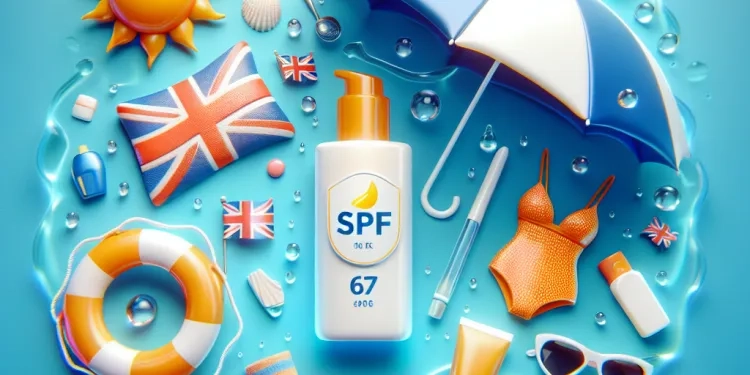
Find Help
More Items From Ergsy search
-

Does sunscreen expire?
Relevance: 100%
-

Can I use expired sunscreen?
Relevance: 95%
-

Do I need sunscreen on cloudy days?
Relevance: 94%
-

How often should I reapply sunscreen?
Relevance: 92%
-

Which factor sunscreen should I use?
Relevance: 89%
-

What's the difference between chemical and physical sunscreens?
Relevance: 89%
-

Can makeup with SPF replace sunscreen?
Relevance: 88%
-

How does sunscreen with SPF 20 compare to SPF 50?
Relevance: 76%
-

Which sunscreen should I use?
Relevance: 70%
-

Should I use a different SPF for my face and body?
Relevance: 48%
-

What SPF should I use if I have sensitive skin?
Relevance: 47%
-

Do I need a different SPF for water-related activities?
Relevance: 46%
-

What SPF level is recommended to prevent sunburn?
Relevance: 44%
-

Is a higher SPF always better?
Relevance: 44%
-

Does tanning lotion prevent sunburn?
Relevance: 44%
-

What does SPF stand for?
Relevance: 44%
-

Is there a sunscreen that protects against all UV radiation?
Relevance: 43%
-

What SPF should I use if I am going to be outdoors all day?
Relevance: 42%
-

Can sunburn be prevented?
Relevance: 41%
-

How can I be sure that my sunscreen SPF rating is accurate?
Relevance: 38%
-

Self care - sunburn
Relevance: 36%
-

Can dark-skinned individuals get sunburned?
Relevance: 36%
-

At what time of day is the sunburn risk highest?
Relevance: 32%
-

What are UVA and UVB rays?
Relevance: 31%
-

What should I wear during a heatwave?
Relevance: 31%
-

What to do if you're sunburnt
Relevance: 31%
-

What is sunburn?
Relevance: 31%
-

How can I keep children safe during a heatwave?
Relevance: 30%
-

Skin cancer education
Relevance: 29%
-

Why do some people not burn as easily as others?
Relevance: 28%
-

How long does it take for sunburn to appear?
Relevance: 26%
-

Are some people more prone to sunburn?
Relevance: 26%
-

Can sunburns cause permanent damage?
Relevance: 26%
-

Is it possible to be allergic to the sun?
Relevance: 26%
-

How can I keep my kids cool during a heatwave?
Relevance: 25%
-

What causes sunburn?
Relevance: 24%
-

How effective are mosquito repellents in the UK?
Relevance: 24%
-

Is peeling a normal part of sunburn recovery?
Relevance: 24%
-

What is Sunburn?
Relevance: 23%
-

What are the long-term effects of sunburn?
Relevance: 23%
Understanding Sunscreen Protection
When choosing a sunscreen, the primary consideration should be its ability to protect your skin from the harmful effects of ultraviolet (UV) rays. Ultraviolet rays are of two types: UVA and UVB. UVA rays penetrate the skin more deeply and are associated with aging, while UVB rays are responsible for sunburn. Both contribute to the risk of skin cancer.
Look for a sunscreen labeled as "broad-spectrum" to ensure it offers protection against both UVA and UVB rays. The Sun Protection Factor (SPF) rating indicates the level of protection against UVB rays. In the UK, using a sunscreen with at least SPF 30 is recommended for adequate protection.
Choosing the Right SPF
The SPF number represents how long you might be able to stay in the sun without burning, compared to if you weren’t wearing any sunscreen. For example, an SPF of 30 means you can stay in the sun 30 times longer without burning than you could without sunscreen. However, high SPF numbers can sometimes give a false sense of security. It's vital to reapply sunscreen every two hours, or more often if swimming or sweating.
It's crucial to choose a sunscreen that suits the specific conditions you'll be in. For everyday use in the UK, where direct sunlight isn't always intense, an SPF 30 sunscreen is sufficient. However, if you are spending an extended period outdoors or in areas with higher UV exposure, such as skiing or beach holidays, consider using an SPF 50 product.
Sunscreen Ingredients to Consider
Sunscreens come in different formulations, utilizing various active ingredients. Some people prefer mineral sunscreens that contain zinc oxide or titanium dioxide. These ingredients offer immediate protection by physically blocking UV rays. They are often recommended for sensitive skin and are less likely to cause irritation.
Chemical sunscreens, on the other hand, contain organic compounds like oxybenzone, avobenzone, and octocrylene that absorb UV radiation. These are typically less visible on the skin and easier to apply but might take 20 minutes after application to become effective.
Application and Skin Type
Consider your skin type when selecting sunscreen. If your skin is oily or acne-prone, opt for a non-comedogenic formula that won’t clog pores. For dry skin, a moisturizing sunscreen with hydrating ingredients can offer additional benefits.
Application is key to effectiveness. Apply a generous amount of sunscreen to all exposed skin areas at least 15 minutes before going outside. Be mindful of commonly missed spots, such as ears, back of the neck, and tops of feet. Reapply regularly, especially after swimming or sweating, to maintain protection.
Conclusion
Choosing the right sunscreen involves considering factors like SPF level, active ingredients, and suitability for your skin type and activities. Opt for a broad-spectrum sunscreen and ensure regular application for optimal protection. Consult with a dermatologist if you have specific concerns or conditions that might affect your choice of sunscreen.
Understanding Sunscreen Protection
When you pick a sunscreen, make sure it protects your skin from ultraviolet (UV) rays. UV rays come from the sun and can hurt your skin. There are two types of UV rays: UVA and UVB. UVA rays go deep into your skin and cause aging. UVB rays cause sunburn. Both can lead to skin cancer.
You should look for a sunscreen that says "broad-spectrum" on the label. This means it protects you from both UVA and UVB rays. The Sun Protection Factor (SPF) number shows how well it protects against UVB rays. In the UK, use a sunscreen with at least SPF 30 to be safe.
Choosing the Right SPF
The SPF number tells you how much longer you can stay in the sun without getting burned. For example, SPF 30 means you can be in the sun 30 times longer than without sunscreen. Remember, high SPF numbers don't mean you can stay outside all day. You need to put on more sunscreen every two hours and more often if you swim or sweat.
Think about what you will be doing. For normal days in the UK, SPF 30 is usually enough. But if you're going to be outside for a long time or in strong sunlight, like at the beach or skiing, choose SPF 50.
Sunscreen Ingredients to Consider
Sunscreens have different ingredients. Some people like mineral sunscreens with zinc oxide or titanium dioxide. These give quick protection by blocking UV rays and are good for sensitive skin.
Chemical sunscreens have ingredients like oxybenzone and avobenzone. They soak up UV rays and are usually less visible on your skin. But they can take 20 minutes to start working.
Application and Skin Type
Think about your skin type when picking sunscreen. If your skin is oily or has acne, use a non-comedogenic sunscreen that won't block pores. For dry skin, pick one with extra moisture.
Putting sunscreen on right is important. Use a lot on all skin that's out in the sun, at least 15 minutes before you go outside. Don't forget spots like your ears, neck, and tops of your feet. Reapply often, especially after swimming or sweating.
Conclusion
Choosing the best sunscreen means looking at things like SPF number, ingredients, and if it's right for your skin and activities. Always pick a broad-spectrum sunscreen and use it often. If you have special skin needs, talk to a skin doctor (dermatologist) for advice.
Frequently Asked Questions
Useful Links
- Ergsy carfully checks the information in the videos we provide here.
- Videos shown by Youtube after a video has completed, have NOT been reviewed by ERGSY.
- To view, click the arrow in centre of video.
- Most of the videos you find here will have subtitles and/or closed captions available.
- You may need to turn these on, and choose your preferred language.
- Go to the video you'd like to watch.
- If closed captions (CC) are available, settings will be visible on the bottom right of the video player.
- To turn on Captions, click settings .
- To turn off Captions, click settings again.
More Items From Ergsy search
-

Does sunscreen expire?
Relevance: 100%
-

Can I use expired sunscreen?
Relevance: 95%
-

Do I need sunscreen on cloudy days?
Relevance: 94%
-

How often should I reapply sunscreen?
Relevance: 92%
-

Which factor sunscreen should I use?
Relevance: 89%
-

What's the difference between chemical and physical sunscreens?
Relevance: 89%
-

Can makeup with SPF replace sunscreen?
Relevance: 88%
-

How does sunscreen with SPF 20 compare to SPF 50?
Relevance: 76%
-

Which sunscreen should I use?
Relevance: 70%
-

Should I use a different SPF for my face and body?
Relevance: 48%
-

What SPF should I use if I have sensitive skin?
Relevance: 47%
-

Do I need a different SPF for water-related activities?
Relevance: 46%
-

What SPF level is recommended to prevent sunburn?
Relevance: 44%
-

Is a higher SPF always better?
Relevance: 44%
-

Does tanning lotion prevent sunburn?
Relevance: 44%
-

What does SPF stand for?
Relevance: 44%
-

Is there a sunscreen that protects against all UV radiation?
Relevance: 43%
-

What SPF should I use if I am going to be outdoors all day?
Relevance: 42%
-

Can sunburn be prevented?
Relevance: 41%
-

How can I be sure that my sunscreen SPF rating is accurate?
Relevance: 38%
-

Self care - sunburn
Relevance: 36%
-

Can dark-skinned individuals get sunburned?
Relevance: 36%
-

At what time of day is the sunburn risk highest?
Relevance: 32%
-

What are UVA and UVB rays?
Relevance: 31%
-

What should I wear during a heatwave?
Relevance: 31%
-

What to do if you're sunburnt
Relevance: 31%
-

What is sunburn?
Relevance: 31%
-

How can I keep children safe during a heatwave?
Relevance: 30%
-

Skin cancer education
Relevance: 29%
-

Why do some people not burn as easily as others?
Relevance: 28%
-

How long does it take for sunburn to appear?
Relevance: 26%
-

Are some people more prone to sunburn?
Relevance: 26%
-

Can sunburns cause permanent damage?
Relevance: 26%
-

Is it possible to be allergic to the sun?
Relevance: 26%
-

How can I keep my kids cool during a heatwave?
Relevance: 25%
-

What causes sunburn?
Relevance: 24%
-

How effective are mosquito repellents in the UK?
Relevance: 24%
-

Is peeling a normal part of sunburn recovery?
Relevance: 24%
-

What is Sunburn?
Relevance: 23%
-

What are the long-term effects of sunburn?
Relevance: 23%